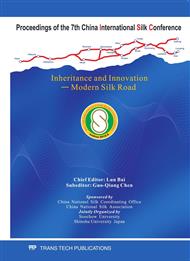p.1016
p.1024
p.1030
p.1035
p.1040
p.1045
p.1052
p.1059
p.1070
Purchasing Motives of Clothing Product by Chinese Woman Consumers’ Socio-Economic Variables
Abstract:
The purpose of this study is to investigate difference in the purchasing motives of clothing product according to the socio-economic variables of Chinese women consumers. The subjects of the research were women in their 20s-50s who were residing in Beijing, China. A total of 312 questionnaires were used for final analyses. Socio-economic variables were measured upon being classified into educational background, occupation and total household income. Purchasing motives of clothing product were classified into ‘clothing design and seasonal adaption motive,’ ‘personality and fashion consciousness motive,’ ‘impulse buying motive,’ ‘influence from others motive,’ ‘economic factor motive,’ ‘advertisements and sales promotions motive,’ ‘own ostentation motive,’ and ‘clothing utilitarian motive.’ The consumers with high educational background was found to have high ‘clothing design and seasonal adaption motive,’ such as ‘Because design is attractive’; high ‘impulse buying motive,’ such as ‘Because attractive clothes have been found’; high ‘own ostentation motive,’ such as ‘To show off economic affordability’; and high ‘clothing utilitarian motive,’ such as ‘Because it can easily make a harmony in any place.’ Students showed high ‘clothing design and seasonal adaption motive,’ such as ‘Because design is attractive’; high ‘impulse buying motive,’ such as ‘Because attractive clothes have been found’; high ‘economic factor motive,’ such as ‘To purchase at low price during the term of discount; and high ‘clothing utilitarian motive,’ such as ‘Because it can easily make a harmony in any place.’ The consumers whose occupation was production worker showed the highest ‘advertisements and sales promotions motive,’ such as ‘Because free gift offered along with clothing is good’; and also the highest ‘clothing utilitarian motive,’ such as ‘Because it looks durable’; but the lowest ‘clothing design and seasonal adaption motive,’ such as ‘Because it makes a good harmony with own image and atmosphere’. Those whose occupation was desk worker/professional worker/technical worker showed the highest ‘advertisements and sales promotions motive,’ such as ‘After having seen advertisement delivered by mail’; and also the highest ‘own ostentation motive,‘ such as ‘To show off economic affordability.’ The consumers with high total household income showed high ‘influence from others motive,’ such as ‘Because of the recommendation by salesperson’; high ‘advertisements and sales promotions motive,’ such as ‘After having seen advertisement delivered by mail’; and also high ‘own ostentation motive,’ such as ‘To show off economic affordability.’
Info:
Periodical:
Pages:
1059-1069
Citation:
Online since:
January 2011
Authors:
Price:
Сopyright:
© 2011 Trans Tech Publications Ltd. All Rights Reserved
Share:
Citation:


